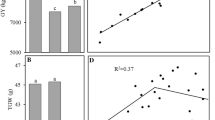Summary
Wheat breeding efforts for a half century in Japan were investigated by using of 129 varieties registered in MAFF from 1929 to 1984 in the view point of case history for three years. Varieties released in each breeding station are classified apparently by growth habit associated closely with duration of the cold requirement. Heading date is earlier in varieties released in southwest breeding stations (southern varieties) than in varieties released in northern breeding stations (northern varieties). Culm length is higher and the pre-harvest sprouting is more sensitive in northern varieties. In quality characters, northern varieties has the higher milling rate, lower apparent amylose content and larger particle size of flour. In varieties released in the Tohoku district, trend of breeding direction with time is smaller ear numbers and larger 1,000-grain weight and greater resistance to powdery mildew. In varieties released in the Kyushu district, a significant correlation with released year was clearly observed with regard to early maturity, short culm length, less grain crude protein content, less apparent amylose content and higher milling rate on breeding advancement.
Similar content being viewed by others
References
Gotoh, T., 1979. Ecological and genetic studies on heading behavior of common wheat. Bull. Tohoku Natl. Agric. Exp. Stn. 59: 1–69.
Ito, R., 1973. Studies on the selection of rice strain by grain/straw ratio in rice breeding. J. Central Agric. Exp. Stn. 17: 1–59.
Nakamura, S., S. Matsumoto & I. Watanabe, 1979. Comparison of characteristics between new and old soybean varieties recommended in Tohoku district. Bull. Tohoku Natl. Agric. Exp. Stn. 60: 151–160.
National Astronomical Observatory, 1994. Science data book. Maruzen Press, Tokyo.
Tanaka, A., J. Yamaguchi, Y. Shimazaki & K. Shibata, 1968. Historical change of plant type of rice plant in Hokkaido. Plant & Manure in Japan 39: 527–534.
Takeda, T., M. Oka & W. Agata, 1983a. Characteristics of dry matter and grain production of rice cultivars in the warmer part of Japan. I. Comparison of dry matter reproduction between old and new types of rice cultivars. Jap. J. Crop Sci. 52: 299–306.
Takeda, T., M. Oka & W. Agata, 1983b. Characteristics of dry matter and grain production of rice cultivars in the warmer part of Japan. II. Comparison of grain production between old and new types of rice cultivars. Jap. J. Crop Sci. 53: 12–21.
Tsunoda, S., 1964. Leaf characters and nitrogen response, in Mineral nutrition of rice plant. pp. 401–418. Proceedings of a Symposium at IRRI. Johns Hopkins Press, Baltimore, Maryland. In India by Oxford & IBH Publishing Co., Calcutta.
Yamada, T., 1994. Genetic resources and breeding of wheat and barley in Japan. Wheat Information Service 79: 1–17.
Wheat Quality Research Group, 1981. Studies on local variation of wheat quality in Japan. J. Central Agric. Exp. Stn. Misc. Publ. Natl. Agric. Exp. Stn. 4: 1–108.
Author information
Authors and Affiliations
Rights and permissions
About this article
Cite this article
Hoshino, T., Seko, H. History of wheat breeding for a half century in Japan. Euphytica 89, 215–221 (1996). https://doi.org/10.1007/BF00034608
Received:
Accepted:
Issue Date:
DOI: https://doi.org/10.1007/BF00034608




